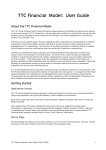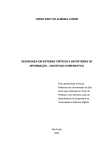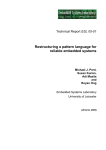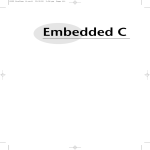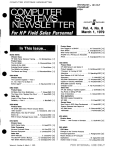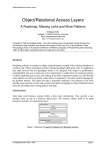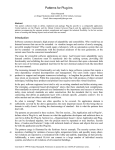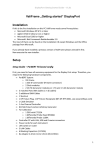Download Manual 5878690
Transcript
Implementing low-cost TTCS systems using assembly language Simon Key, Michael J. Pont and Simon Edwards1 Embedded Systems Laboratory2, University of Leicester, LEICESTER LE1 7RH, UK. Introduction We have previously described a “pattern language” consisting of nearly eighty components, which will be referred to here as the “PTTES Collection” (see Pont, 2001; Pont and Ong, in press). This language is intended to support the development of reliable embedded systems: the particular focus of the collection is on systems with a time triggered, co-operatively scheduled (TTCS) system architecture. In this paper, we present a new pattern – TTCO SCHEDULER (ASSEMBLY LANGUAGE) – which describes how to implement TTCS architectures using small, memory-limited, microcontrollers (such as 8051s, PICs, AVRs or similar devices). Acknowledgements We are grateful to Jorge Ortega-Arjona (our ‘shepherd’ at EuroPLoP 2003) for comments and suggestions on the first drafts of this paper. Copyright Copyright © 2003-2004 by Simon Key, Michael J. Pont and Simon Edwards. Permission is granted to copy this paper for the purposes of EuroPLoP 2003. All other rights reserved. 1 The first phase of the work described in this paper was carried out while Simon Edwards was a Final-Year student at the University of Leicester. Present address: MIRA Ltd, Watling Street, Nuneaton, Warwickshire CV10 0TU,UK 2 http://www.le.ac.uk/eg/embedded TTCO SCHEDULER (ASSEMBLY LANGUAGE) Context • You are developing an embedded application. • You wish to use a time-triggered (software) architecture, based on some form of cooperative scheduler. • You chosen hardware platform (microcontroller) has very limited data memory and/or code memory. Problem How can you create a co-operative scheduler with minimal memory and CPU requirements? Background There are two ways of viewing a (co-operative) scheduler: • At one level, a scheduler can be viewed as a simple operating system that allows tasks (functions) to be called periodically, or - less commonly - on a one-shot basis. • At a lower level, a scheduler can be viewed as a single timer interrupt service routine that is shared between many different tasks. As a result, only one timer needs to be initialised, and any change to the timing generally requires only one function to be altered. Furthermore, we can generally use the same scheduler whether we need to execute 1, 10 or 100 different tasks. Using such a scheduler, we can co-ordinate the execution and interaction of tasks in a highly deterministic manner. By making the scheduler co-operative (that is, only one task as active at any point in time), we simplify the design3 and greatly reduce the potential for task conflicts. Solution We have previously described, in detail, how to create a flexible scheduler using the C programming language (see CO-OPERATIVE SCHEDULER [Pont, 2001, p.255]). In the present pattern, we describe how to create a similar scheduler, using assembly language. By using assembly language, we can significantly reduce the system resource requirements. In the examples, we will use code fragments taken from an 8051-based system. However, the techniques can be applied with virtually any microcontroller. 3 Compared with an equivalent pre-emptive scheduler. Key components An implementation of TTCO SCHEDULER (ASSEMBLY LANGUAGE) has the following key components: 1. The scheduler data structure. 2. An initialisation function. 3. A single interrupt service routine (ISR), used to update the scheduler at regular time intervals. 4. A dispatcher function that causes tasks to be executed when they are due to run. 5. One or more tasks. The links between these components during the program execution are shown schematically in Figure 1. Initialisation Timer overflow ISR Scheduler data structure Dispatcher Task(s) Figure 1: Links between the different scheduler components during the program run. We consider each of these components in the sections that follow. The scheduler data structure To control a task we need to know three basic pieces of information: 1. The location of the task in program memory 2. The initial delay value (when should the task be run for the first time?) 3. The Reload value (if the task is periodic, what is the interval between runs?) The location of the tasks is given in the task list. This is a ‘jump table’ (see Listing 1). ; *** This is where the scheduled tasks go list below in order (1 to 8) TASK_LIST: ajmp TASK1 ; Jump to Task 1 ajmp TASK2 ; Jump to Task 2 ajmp TASK3 ; Jump to Task 3 ajmp TASK4 ; Jump to Task 4 ajmp TASK5 ; Jump to Task 5 ajmp TASK6 ; Jump to Task 6 ajmp TASK7 ; Jump to Task 7 ajmp TASK8 ; Jump to Task 8 SCH_NO_TASK_HERE: ; DO NOT MOVE OR RENAME THIS LINE Listing 1 Task list (file: 8051SCH.ASM) Each task has its own delay and reload values which are entered directly by the programmer into the appropriate task slot (Listing 2). These values are then copied at runtime into RAM memory locations. ;*********************************************************************** ; Scheduled Task Delay and Reload Values ;*********************************************************************** cseg SCH_Delay_Values: db 0x00 ; Delay value for Task 1 db 0x00 ; Delay value for Task 2 db 0x00 ; Delay value for Task 3 db 0x00 ; Delay value for Task 4 db 0x00 ; Delay value for Task 5 db 0x00 ; Delay value for Task 6 db 0x00 ; Delay value for Task 7 db 0x00 ; Delay value for Task 8 SCH_Reload_Values: db 0x63 db 0x00 db 0x00 db 0x00 db 0x00 db 0x00 db 0x00 db 0x00 ; ; ; ; ; ; ; ; Reload Reload Reload Reload Reload Reload Reload Reload value value value value value value value value for for for for for for for for Task Task Task Task Task Task Task Task 1 2 3 4 5 6 7 8 Listing 2 Delay and reload Values (file: TASK_PERIODS.INC) An initialisation function As with most programs the system requires some initialisation. In the case of assembly language programs we are also required to initialise vectors and memory allocations. Vectors When an interrupt occurs the CPU finishes the instruction that it is currently processing and jumps to an area of memory known as a vector. This vector contains a pointer to the relevant ISR. In this case we are considering only one vector, linked to the timer overflow. When the timer reaches its maximum count and ‘overflows’, the ISR “SCH_Update” is called. ;********************************************************************** ; Vectors ;*********************************************************************** CSEG AT 0x0000 ; absolute Segment at Address 0 LJMP MAIN ; reset location (jump to start) CSEG AT 0x002b ; interrupt vector ; *** There is only one interrupt in this program ... LJMP SCH_Update ; timer overflow -> update scheduler CSEG AT 0x0043 ; after all interrupt vectors ;start of main program. Listing 3 Interrupt vectors (file: VECTORS.INC) Memory Allocation In assembly language the location of variables used within the program has to be specified manually. This is done by allocating a name to a section of memory; this name can then be referred to throughout the program (this is similar to variable initialisation in a high-level language). ;*********************************************************************** ; Scheduler Memory Allocation ;*********************************************************************** START_OF_DATA_MEMORY EQU (00h) START_OF_USER_MEMORY EQU (SCH_rloads + SCH_MAX_TASKS) ;scheduler status register SCH_STATUS DATA (START_OF_DATA_MEMORY) ;temp register for Scheduler SCH_temp DATA (START_OF_DATA_MEMORY + 01h) ;general temp register temp DATA (START_OF_DATA_MEMORY + 02h) ; ***Scheduler variables ;Run flags for scheduled tasks SCH_run_f DATA (START_OF_DATA_MEMORY + 04h) ;Run flag mask SCH_run_mask DATA (START_OF_DATA_MEMORY + 05h) ;Current task index SCH_index DATA (START_OF_DATA_MEMORY + 06h) ;Task Dispatcher run flag mask SCH_dis_mask DATA (START_OF_DATA_MEMORY + 07h) ;Task Dispatcher task index SCH_dis_index DATA (START_OF_DATA_MEMORY + 08h) ;Delay values for scheduled tasks ; put in ram comments to the size of the number of tasks -> SCH_MAX_TASKS SCH_delays DATA (START_OF_DATA_MEMORY + 09h) ;Delay values for scheduled tasks ; put in ram comments to the size of the number of tasks -> SCH_MAX_TASKS SCH_rloads DATA (SCH_delays + SCH_MAX_TASKS) ;*********************************************************************** Listing 4 Memory allocation (file: MEMORY_ALLOCATION.INC) Device initialisation To ensure correct operation of the scheduler we have to initialise run time variables, prepare the system timer and prepare any ports used for IO operations. The initialisation of runtime variables consists of copying the task delay and task reload values from non changeable ROM to RAM. Listing 5, shows general configuration settings for the device. initialise: ; *** General Initialisation mov SP,#0x30 clr SWDT ; Set Stack Pointer ; Clear Watchdog timer Listing 5 Initialisation (file: 8051SCH.ASM) Timer initialisation The scheduler is driven by timer “ticks”. These are interrupts generated when a timer register overflows. Listing 6 shows a possible timer initialisation using Timer 2 in an 8051 device. With the timer reload values used here we have a 10 ms period between interrupts. ; *** Initialise timer for scheduler (using TMR2) mov T2CON,#0x10 mov CCEN,#0x00 ; *** The timer preload values mov TH2, #PRELOAD10H mov CRCH, #PRELOAD10H mov TL2, #PRELOAD10L mov CRCL, #PRELOAD10L ; Pre-defined values giving 10ms tick ; *** Enable Timer 2 interrupt, but not the external one. setb ET2 setb EXEN2 Listing 6 Timer initialisation (file: 8051SCH.ASM) In general, the initial task delays and reload values are stored directly in program memory using assembler directives, such as db. If these memory locations are referenced using a label a simple routine to move these fixed values from code memory to RAM can be used. Listing 7 shows the routine used to copy the data code section (scheduler data structure) from ROM to RAM. ; *** Initialise scheduler variables mov SCH_run_f,#0x00 ; Clear all run flags mov SCH_index,#0 ; Reset index counter mov R1,#(SCH_rloads) ; Get address of delay values mov R0,#(SCH_delays) ; Initialise indirect pointer SCH_init_lp: mov DPTR,#SCH_Delay_Values mov A,SCH_index movc A,@A+DPTR mov @R0,A inc R0 mov DPTR,#SCH_Reload_Values mov A,SCH_index movc A,@A+DPTR mov @R1,A inc R1 inc SCH_index mov A,SCH_index ; Get delay value for task[index] ; Get task index value ; Store in array ; ; ; ; Get reload value for task[index] Offset pointer by number of tasks Get task index value Store in array ; decrease index value, if not zero, loop cjne A,#SCH_MAX_TASKS,SCH_init_lp Listing 7 ROM to RAM copy (file: 8051SCH.ASM) To conclude the initialisation, Timer 2 is started and the associated interrupt is enabled (Listing 8). ; *** Enable interrupts and reset TMR0 setb T2I0 ; Set the timer running setb EAL ; Enable interrupts Listing 8 Concluding the scheduler initialisation (file: 8051SCH.ASM) An ISR When the scheduler timer (discussed above) ‘overflows’, the scheduler interrupt service routine (ISR) is executed. The first action taken in the ISR is to clear the timer interrupt flag and save any registers that will be altered within this routine (Listing 9); these registers will be restored at the exit from the function. SCH_Update: clr TF2 push ACC push PSW push 01h push 00h ; Clear Timer 2 interrupt flag ; Save registers that might be needed Listing 9 Performing a context save (file: 8051SCH.ASM) Each of the possible tasks is then checked. A non-zero delay time is decreased by one, and the update function then checks the next task. A zero delay time results in the delay time been re-initialised with the associated reload value, and the run flag for that task is set (Listing 10). ; *** Setup loop counter and run flag mask mov SCH_run_mask,#00000001b ; Init value for run flag mask mov SCH_index,#SCH_MAX_TASKS ; Reset index value to number of tasks ; in scheduler mov A,#SCH_delays mov R0,A ; Get address of SCH_delays mov A,#SCH_rloads ; Get location of first reload ram ; location mov R1,A SCH_Update_lp: mov A,SCH_run_mask cjne @R0,#0,SCH_Task_notready ; Get run flag mask ; Test delay time if not zero task not ; ready ; *** Current task is ready to be run, so set run flag and reload delay ; value SCH_Task_ready: orl SCH_run_f,A ; Set appropriate run flag mov A,@R1 ; Get value being pointed to mov @R0,A ; Store in delay value (task period) AJMP SCH_Update_lp_end ; Jump to end of loop SCH_Task_notready: dec @R0 SCH_Update_lp_end: inc R0 inc R1 mov A,SCH_run_mask rl A mov SCH_run_mask,A djnz SCH_index,SCH_Update_lp ; Task isn't ready to run ; Decrease delay value by 1 ; Increase pointer value by 1 ; Roll run mask one place to left ; Decrease index value, not zero, so ; Loop still tasks to look at Listing 10 The core scheduler “update” code (file: 8051SCH.ASM) Finally, the pre-ISR program context is restored, and system resumes “normal” operation (Listing 11). pop pop pop pop reti 00h 01h PSW ACC ; Restore registers ; Return from interrupt Listing 11 Restoring the pre-ISR context (file: 8051SCH.ASM) A dispatch function We have seen that a run flag is set for a given task to be performed in the SCH_Update function. In this section we see how the flag is used to activate the task that it relates to. Until an interrupt occurs and a run flag is set, the dispatch function sits in an endless loop, ‘sleeping’ between timer ‘ticks’. When a run flag has been set, checks are performed and the associated task is called (Listing 12). ; *** This is the main task dispatcher process. If a task is ready to be run ; then the dispatcher will run it and clear its run flag. orl orl mov jz PCON,#0x01 PCON,#0x20 A,SCH_run_f SCH_Dispatch_Tasks ; ; ; ; Enter idle mode (#1) Enter idle mode (#2) goto sleep Test run flags No tick -> loop ; initial value for mask, load dispatcher run flag mask mov SCH_dis_mask,#00000001b ; get number of tasks in scheduler, load dispatcher task index mov SCH_dis_index,#SCH_MAX_TASKS SCH_Dispatch_Tasks_lp: mov A,SCH_dis_mask ; Get run flag mask anl A,SCH_run_f ; Logical AND with run flags ; if result was zero, so no run flag there, go back to loop jz SCH_Dispatch_Tasks_end ; *** Task needs to be run, so clear run flag and jump to task mov A,SCH_dis_mask ; Get inverse of run flag mask cpl A anl SCH_run_f,A ; Clear appropriate run flag mov DPTR,#TASK_LIST ; Load start of task lists mov A,#SCH_MAX_TASKS subb A,SCH_dis_index ; Add current task no clr C ; Clear carry rlc A ; x2 to get 'real' code location jmp @A+DPTR ; Jmp to task Listing 12 A possible dispatch function (file: 8051SCH.ASM) The tasks have been stored in a jump table, and the relevant task number is added to the base address of this table (TASK_LIST). The resulting value is then stored in the program counter, causing a ‘jump’ to the task (Listing 13). ; *** This is where the scheduled tasks go. ; the list below in order (1 to 8) TASK_LIST: ajmp TASK1 ; Jump to Task ajmp TASK2 ; Jump to Task ajmp TASK3 ; Jump to Task ajmp TASK4 ; Jump to Task ajmp TASK5 ; Jump to Task ajmp TASK6 ; Jump to Task ajmp TASK7 ; Jump to Task ajmp TASK8 ; Jump to Task SCH_NO_TASK_HERE: 1 2 3 4 5 6 7 8 ; DO NOT MOVE OR RENAME THIS LINE Listing 13 A possible implementation of the task list jump table (file: 8051SCH.ASM) Having checked (and, if necessary, run) all possible tasks, the whole process starts again (Listing 14). SCH_Dispatch_Tasks_end: mov A,SCH_dis_mask ; Roll run flag mask one place left clr C rlc A mov SCH_dis_mask,A ; decrease task index , if not zero more tasks to do djnz SCH_dis_index,SCH_Dispatch_Tasks_lp ajmp SCH_Dispatch_Tasks ; Super loop! Listing 14 A dispatch loop (file: 8051SCH.ASM) Tasks For demonstration purposes, we include a simple task that will flash an LED connected to an external pin (50% duty cycle, 0.5 Hz). ;*********************************************************************** ; Function: LED_Flash ; Description: Flashes LED on port0 pin0 on and off ; Pre: None ; Post: None ;*********************************************************************** TASK1: LED_Flash: mov A,LED_Status ; Is the led on? jz LED_on ; No – jump to turn it on clr LED_PORT ; Yes – turn it off mov LED_Status,#00 ; Update the LED status ajmp SCH_Dispatch_Tasks_end LED_on: setb mov ajmp LED_PORT LED_Status,#01 SCH_Dispatch_Tasks_end ; Turn LED on ; Update the LED status ; Return from scheduled task Listing 15 Flash LED Task (file: TASK1.ASM) Reliability and safety implications Many questions have been raised about the suitability of assembly language4 for use in applications which are safety-related or safety critical (see, for example, Cullyer et al., 1991; Cooling, 2003). 4 It should also be noted that C is rarely considered to be an ideal language for safety-critical systems. It is undoubtedly the case that implementing – say – a very large and complex air-traffic control system entirely in assembly language would probably not be sensible. However, in the present pattern, we focus on systems implemented using microcontrollers with very limited memory. A consequence of this is that the code size is (compared with many realtime and embedded systems) very small. What is not clear is whether – in such small systems, where the code can be carefully and completely checked – there are significant safety implications resulting from the use of assembly language vs. C. Further studies are required in order to clarify this issue. Hardware resource implications Embedded systems implemented using assembly language generally require significantly less memory than those implemented in high-level languages. To illustrate the likely savings in memory when using this pattern, please consider the results shown in Table 1. Microcontroller Manufacturer Size of assembly compared to C (ROM) Size of assembly compared to C (RAM) One task Five tasks 16F877 Microchip 20% 39% 27% AT90s2343 Atmel 26% 35% 31% C515C Infineon 32% 76% 46% Table 1: A comparison of the memory requirements for schedulers implemented in assembly language and C, for a range of different microcontrollers (all figures are approximate). In this table, the comparison is between an implementation of Co-operative scheduler (Pont, 2001, p.255), implemented in C, and the assembly-language scheduler described in the present pattern. Overall, these figures illustrate that the assembly-language implementations require around a third (or less) of the code memory than is required in the C-language implementation. Savings in code memory are more variable (in this table), but are still substantial. These memory savings (particularly code-memory reductions) translate directly into reduced costs. This is illustrated in Figure 2, which shows the cost per device for a family of 8051 microcontrollers. The only difference between these microcontrollers is the (code) memory size. C osts in Pounds Per 100 units M ic ro co n trol l er C ost (£ ) £ 10.00 £7.90 £8.00 £ 5.66 £6.00 £4.00 £4.46 £ 3.82 8K ROM 16K ROM 32K ROM 64 K ROM £2.00 £0.00 P roc e sso r P8 7C 51RA 8 K P 87 C5 1R B 16 K P 87 C5 1R C 32 K P 87 C5 1R D 64 K Figure 2 Relating memory size to device costs When considering the resource implications of this approach to scheduling, please note that the scheduler presented in this paper is divided into multiple source files. This has been done because, when compared with a single-source version, we find this version much easier to use. Please bear in mind that this approach increases the code memory requirements (when using a single task) by 42 bytes (the increase is much less as subsequent tasks are added). Portability Assembly language is not a portable language, when compared to any high level language. For example porting the scheduler code from a Microchip 16F877 to an AVR 90S2323 generally requires a complete rewrite. However within product families, manufacturers maintain compatibility of instruction sets. For example the 8051 or AVR allows quick porting of this scheduler between chips within the same range. Similar observations are noted in other families. Related patterns and alternative solutions CO-OPERATIVE SCHEDULER [Pont, 2001, p.255] describes a similar architecture, implemented using the C programming language. Overall strengths and weaknesses From previous work we have the following strengths for a co-operative scheduler: ☺ The scheduler behaviour is highly predictable. ☺ The scheduler is much simpler than pre-emptive alternatives. ☺ The scheduler is an integral part of the developed application. Additionally for the assembly scheduler (compared with an implementation in “C”), we have one key strength: ☺ By using this scheduler we can reduce costs, through the use of a microcontroller with less code memory. General weaknesses of co-operative scheduling: External events have to be polled, which may delay response times under some circumstances. Tasks that exceed the system tick interval can greatly disrupt the system performance. Specifically for the assembly scheduler: Knowledge of the individual of microcontroller is required in order to write effective code. In the implementation presented here, a maximum of eight tasks that can be scheduled. The assembly-language scheduler is not as straightforward to use as the C-language scheduler and some “hand crafting” is required. Example: An 8051 assembly scheduler We present a complete listing of an assembly-language scheduler for the 8051 microcontroller in this section. It is targeted at an Infineon C515C microcontroller running at 10 MHz, and produces a 1ms tick. An example “flashing LED” task is included. Please note that, as discussed in “Hardware resource implications”, this scheduler is split across multiple source files. This is intended to make the use of the program more straightforward. We can illustrate the use of these various files by outlining how we would add a simple “flashing LED” task to the scheduler: • Create the ‘flashing LED’ task (TASK1.ASM, Listing 22) • Modify the task’s delay and reload values as required (TASK_PERIODS.INC, Listing 21) • Specify the port pin to be used (PORTS.INC, Listing 20) • Modify the number of tasks and - if required - the scheduler timing (TIMING.INC, Listing 17) • Allocate memory for the task variables (file: MEMORY_ALLOCATION.INC, Listing 18) ;************************************************************************ ; * ; Description 8051 Assembler scheduler * ; * ;************************************************************************ ; * ; Filename: 8051SCH.ASM * ; Company: * ; Version: Author: Date: Modification: * ; 1.0 S Key 09/12/02 Created * ; 1.1 S Key 30/05/03 separate files for easy of use * ; * ;************************************************************************ ; * ; Files required: * ; REG515C.H, TIMING.INC, MEMORY_ALLOCATION.INC, vectors.inc * ; ports.inc, task_periods.inc, TASK1.ASM, task2.asm, task3.asm * ; task4.asm, task5.asm, task6.asm, task7.asm, task8.asm * ; * ;************************************************************************ ; * ; Notes: * ; Base scheduler for 8051 * ; THIS FILE DOES NOT REQUIRE MODIFICATION * ; * ;***********************************************************************/ $NOMOD51 $INCLUDE (REG515C.H) ; disable predefined 8051 registers ;************************************************************************ ; Sample prescale and reload values ;************************************************************************ $include (TIMING.INC) ;************************************************************************ ; Memory Allocation ;************************************************************************ $include (MEMORY_ALLOCATION.INC) ;************************************************************************ ; Vectors ;************************************************************************ $include (vectors.inc) ;************************************************************************ ; Main Program ;************************************************************************ MAIN: ;************************************************************************ ; Initialise Ports ;************************************************************************ $include (ports.inc) ; *** Initialise Ports mov SP ,#0x30 clr SWDT ; *** Initialise timer for scheduler (using TMR2) mov T2CON ,#0x10 mov CCEN ,#0x00 ; *** The timer preload values. mov TH2 , #PRELOAD10H mov CRCH , #PRELOAD10H mov TL2 , #PRELOAD10L mov CRCL , #PRELOAD10L ; *** Enable Timer 2 interrupt, but not the external one. setb ET2 setb EXEN2 ; *** Initialise scheduler variables mov SCH_run_f,#0x00 mov SCH_index,#0 mov mov R1,#(SCH_rloads) R0,#(SCH_delays) ;clear all run flags ;reset index counter ;get address of delay values ;initialise indirect pointer SCH_init_lp: mov DPTR,#SCH_Delay_Values mov A,SCH_index movc A,@A+DPTR mov @R0,A inc R0 mov DPTR,#SCH_Reload_Values mov A,SCH_index movc A,@A+DPTR mov @R1,A inc R1 inc SCH_index mov A,SCH_index cjne A,#SCH_MAX_TASKS,SCH_init_lp ; decrease index, if not 0, loop ; *** Enable interrupts and reset TMR2 setb T2I0 setb EAL ; Set the timer running ; enable interrupts ;get delay value for task[index] ;get task index value ;store in array ;get reload value for task[index] ;offset pointer by number of tasks ;get task index value ;store in array SCH_Dispatch_Tasks: ; *** This is the main task dispatcher process. If a task is ready to be run ; then the dispatcher will run it and clear its run flag. ORL PCON,#0x01 ; Enter idle mode (#1) ORL PCON,#0x20 ; Enter idle mode (#2) mov A,SCH_run_f ; test run flags jz SCH_Dispatch_Tasks ; no tick so loop mov SCH_dis_mask,#00000001b ; init value for mask, load ; dispatcher run flag mask mov SCH_dis_index,#SCH_MAX_TASKS ; get number of tasks in scheduler, ; load dispatcher task index SCH_Dispatch_Tasks_lp: mov A,SCH_dis_mask anl A,SCH_run_f jz SCH_Dispatch_Tasks_end ; Get run flag mask ; AND with run flags ; if result is 0, run flag is clear ; go back to loop ; *** Task needs to be run, so clear run flag and jump to task mov A,SCH_dis_mask ; Get inverse of run flag mask cpl A anl SCH_run_f,A ; Clear appropriate run flag mov mov subb clr rlc jmp DPTR,#TASK_LIST A,#SCH_MAX_TASKS A,SCH_dis_index C A @A+DPTR ; Load start of task lists ; ; ; ; Add current task number Clear carry x2 to get 'real' code location Jump to task ; *** This is where the scheduled tasks go list below in order (1 to 8) TASK_LIST: ajmp TASK1 ; Jump to Task 1 ajmp TASK2 ; Jump to Task 2 ajmp TASK3 ; Jump to Task 3 ajmp TASK4 ; Jump to Task 4 ajmp TASK5 ; Jump to Task 5 ajmp TASK6 ; Jump to Task 6 ajmp TASK7 ; Jump to Task 7 ajmp TASK8 ; Jump to Task 8 SCH_NO_TASK_HERE: ; DO NOT MOVE OR RENAME THIS LINE SCH_Dispatch_Tasks_end: mov A,SCH_dis_mask ; Roll run flag mask one place left clr C rlc A mov SCH_dis_mask,A djnz SCH_dis_index,SCH_Dispatch_Tasks_lp ; decrease task index, ; - if not zero, ; more task to do ajmp SCH_Dispatch_Tasks ; Super loop! ;************************************************************************ ; Scheduler Functions ;************************************************************************ ;************************************************************************ ; Function: SCH_Update ; Description: Services TMR2 overflow interrupt and processes all tasks ; Pre: None ; Post: None ;************************************************************************ SCH_Update: clr TF2 push push push push ACC PSW 01h 00h ; Clear Timer 2 interrupt flag ; Save registers that might be needed ; *** Setup loop counter and run flag mov SCH_run_mask,#00000001b ; mov SCH_index,#SCH_MAX_TASKS ; mov A,#SCH_delays mov R0,A ; mov A,#SCH_rloads ; mov R1,A SCH_Update_lp: mov A,SCH_run_mask cjne @R0,#0,SCH_Task_notready mask Init value for run flag mask Reset index value to number of tasks Get address of SCH_delays Get location of first reload ram location ; Get run flag mask ; Test delay time ; *** Current task is ready to be run, so set run flag and reload delay value SCH_Task_ready: orl SCH_run_f,A ; Set appropriate run flag mov A,@R1 ; Get value being pointed to mov @R0,A ; Store in delay value (task period) AJMP SCH_Update_lp_end ; Jump to end of loop SCH_Task_notready: dec @R0 SCH_Update_lp_end: inc R0 inc R1 mov A,SCH_run_mask rl A mov SCH_run_mask,A djnz SCH_index,SCH_Update_lp pop pop pop pop 00h 01h PSW ACC reti ; Task isn't ready to be run ; Decrease delay value by one ; Increase pointer value by one ; Roll run mask one place to left ; Decrease index value, ; not zero, so more to check ; Restore registers ; Return from interrupt ;*********************************************************************** ; Task Name, Scheduled Task Delay and Reload Values ;*********************************************************************** $include (task_periods.inc) ;*********************************************************************** ; Scheduled Tasks ;*********************************************************************** $include $include $include $include $include $include $include $include (TASK1.ASM) (task2.asm) (task3.asm) (task4.asm) (task5.asm) (task6.asm) (task7.asm) (task8.asm) end ;*********************************************************************** ; End of Program ;*********************************************************************** Listing 16 Assembly-language scheduler for the 8051 microcontroller, main program (file: 8501SCH.ASM) ;************************************************************************ ; * ; Description 8051 c515c Assembler scheduler * ; * ;************************************************************************ ; * ; Filename: TIMING.INC * ; Company: * ; Version: Author: Date: Modification: * ; 1.0 S Key 09/12/02 Created * ; 1.1 S Key 30/05/03 separate files for easy of use * ; * ;************************************************************************ ; * ; Files required: * ; * ; * ;************************************************************************ ; * ; Notes: * ; This section deals with the timing of the scheduler, As set the * ; tick is 1 ms vary these according to the settings below or work * ; out your own. note some ACCURATE timings are not possible. * ; * ;***********************************************************************/ ;************************************************************************ ; Sample prescale and reload values ; ; +------------+------------+----------------+ ; | PRELOAD10h | PRELOAD10l | time generated | ; +------------+------------+----------------+ ; | 0xBE | 0xE5 | ~1ms @ 10 MHz | ; +------------+------------+----------------+ ; | 0xB1 | 0xE0 | 1ms @ 12 MHz | ; +------------+------------+----------------+ ; ;************************************************************************ SCH_MAX_TASKS equ (01h) ;Maximum number of tasks (MIN = 1) ;MIN = 1, MAX = 7 (depends on task variables) ; Oscillator / resonator frequency (in Hz) e.g. (11059200UL) OSC_FREQ equ (10000000) ; Number of oscillations per instruction (6 or 12) ;OSC_PER_INST equ (6) ;PRELOAD10 equ (65536 - (OSC_FREQ / (OSC_PER_INST * 100))) ;PRELOAD10H equ (PRELOAD10 / 256) ;0xd7 PRELOAD10H equ (0xbe) ;PRELOAD10L equ (PRELOAD10 % 256) ; 0xd1 PRELOAD10L equ (0xe5) ;************************************************************************ ; End of File ;************************************************************************ Listing 17 Scheduler ‘tick’ definition (file: TIMING.INC) ;************************************************************************ ; * ; Description 8051 c515c Assembler scheduler * ; * ;************************************************************************ ; * ; Filename: MEMORY_ALLOCATION.INC * ; Company: * ; Version: Author: Date: Modification: * ; 1.0 S Key 09/12/02 Created * ; 1.1 S Key 30/05/03 separate files for easy of use * ; * ;************************************************************************ ; * ; Files required: * ; * ; * ;************************************************************************ ; * ; Notes: * ; This section deals with the allocation of memory to scheduler * ;and user variables. do not modify the scheduler variables, * ;unless REALLY necessary. * ; * ;***********************************************************************/ ; DO NOT MODIFY THIS SECTION ;************************************************************************ ; Scheduler Memory Allocation ;************************************************************************ START_OF_DATA_MEMORY START_OF_USER_MEMORY ; Misc variables SCH_STATUS SCH_temp temp DATA DATA DATA EQU EQU (00h) (SCH_rloads + SCH_MAX_TASKS) (START_OF_DATA_MEMORY) (START_OF_DATA_MEMORY + 01h) (START_OF_DATA_MEMORY + 02h) ; sched status reg ; temp reg for sched ; general temp reg (START_OF_DATA_MEMORY (START_OF_DATA_MEMORY (START_OF_DATA_MEMORY (START_OF_DATA_MEMORY (START_OF_DATA_MEMORY ; ; ; ; ; ; Scheduler variables SCH_run_f DATA SCH_run_mask DATA SCH_index DATA SCH_dis_mask DATA SCH_dis_index DATA + + + + + 04h) 05h) 06h) 07h) 08h) Run flags for tasks Run flag mask Current task index Dispatch run flag msk Dispatch task index ; Delay values for scheduled tasks ; put in RAM comments to the size of the num of tasks -> SCH_MAX_TASKS SCH_delays DATA (START_OF_DATA_MEMORY + 09h) ; Delay values for scheduled tasks ; put in RAM comments to the size of the num of tasks -> SCH_MAX_TASKS SCH_rloads DATA (SCH_delays + SCH_MAX_TASKS) ;************************************************************************ ; END OF DO NOT MODIFY ; user variables; ; define all user variables for start of user memory ;Scheduled Task One Variables LED_Status DATA (START_OF_USER_MEMORY) ;led status register ;Scheduled Task Two Variables ; task_two_variable DATA (START_OF_USER_MEMORY + 01h) ;example ;Scheduled Task Three Variables ;Scheduled Task Four Variables ;Scheduled Task Five Variables ;Scheduled Task Six Variables ;Scheduled Task Seven Variables ;Scheduled Task Eight Variables ;************************************************************************ ; End of File ;************************************************************************ Listing 18 Memory and register allocation (file: MEMORY_ALLOCATION.INC) ;************************************************************************ ; * ; Description 8051 c515c Assembler scheduler * ; * ;************************************************************************ ; * ; Filename: vectors.inc * ; Company: * ; Version: Author: Date: Modification: * ; 1.0 S Key 09/12/02 Created * ; 1.1 S Key 30/05/03 separate files for easy of use * ; * ;************************************************************************ ; * ; Files required: * ; * ; * ;************************************************************************ ; * ; Notes: * ; * ; * ; * ;***********************************************************************/ ;************************************************************************ ; Vectors ;************************************************************************ CSEG LJMP AT MAIN 0x0000 ; reset ; reset location (jump to start) CSEG AT 0x002b ; timer 2 overflow ; *** There is only one interrupt in this program.... ljmp SCH_Update CSEG AT 0x0043 ;timer has overflowed, so update scheduler ; after all interrupt vectors ;start of main program. ;************************************************************************ ; End of File ;************************************************************************ Listing 19 8051 C515C Vector table (file: VECTORS.INC) ;************************************************************************ ; * ; Description 8051 c515c Assembler scheduler * ; * ;************************************************************************ ; * ; Filename: ports.inc * ; Company: * ; Version: Author: Date: Modification: * ; 1.0 S Key 09/12/02 Created * ; 1.1 S Key 30/05/03 separate files for easy of use * ; * ;************************************************************************ ; * ; Files required: * ; * ; * ;************************************************************************ ; * ; Notes: * ; This section deals with the port settings. I find it easier to * ; give the port a name such as LED_PORT. Then if you port to a * ; different device you only need to change the port description * ; in this file * ; * ;***********************************************************************/ ; *** Initialise Ports LED_PORT equ (P0.0) ;************************************************************************ ; End of File ;************************************************************************ Listing 20 Port definition file (file: PORTS.INC) ;************************************************************************ ; * ; Description 8051 c515c Assembler scheduler * ; * ;************************************************************************ ; * ; Filename: task_periods.inc * ; Company: * ; Version: Author: Date: Modification: * ; 1.0 S Key 09/12/02 Created * ; 1.1 S Key 30/05/03 separate files for easy of use * ; * ;************************************************************************ ; * ; Files required: * ; * ; * ;************************************************************************ ; * ; Notes: * ; This section deals with the periods of all the task, enter the * ; start delay and interval between the repeat of the tasks below * ; * ;***********************************************************************/ ;************************************************************************ ; Scheduled Task Delay and Reload Values ;************************************************************************ cseg SCH_Delay_Values: db db db db db db db db 0x00 0x00 0x00 0x00 0x00 0x00 0x00 0x00 ; ; ; ; ; ; ; ; Delay Delay Delay Delay Delay Delay Delay Delay value value value value value value value value ; ; ; ; ; ; ; ; Reload Reload Reload Reload Reload Reload Reload Reload for for for for for for for for Task Task Task Task Task Task Task Task 1 2 3 4 5 6 7 8 SCH_Reload_Values: db db db db db db db db 0x31 0x00 0x00 0x00 0x00 0x00 0x00 0x00 value value value value value value value value for for for for for for for for Task Task Task Task Task Task Task Task 1 2 3 4 5 6 7 8 ;************************************************************************ ; End of File ;************************************************************************ Listing 21 Scheduler task period definitions (file: TASK_PERIODS.IN) ;************************************************************************ ; Scheduled Tasks ;************************************************************************ ;************************************************************************ ; Function: LED_Flash ; Description: Flashes LED on port0 pin0 on and off ; Pre: None ; Post: None ;************************************************************************ TASK1: LED_Flash: mov A,LED_Status jz LED_on clr LED_PORT mov LED_Status,#00 ajmp SCH_Dispatch_Tasks_end LED_on: setb mov ajmp LED_PORT LED_Status,#01 SCH_Dispatch_Tasks_end ; ; ; ; is led on? no got turn it on turn off set status ;turn LED on ;set status ;Return from scheduled task ;************************************************************************ ; End of File ;************************************************************************ Listing 22 Task1: Flashing LED (file: TASK1.ASM) ;************************************************************************ ; Scheduled Tasks ;************************************************************************ ;************************************************************************ ; Function: ; Description: ; Pre: None ; Post: None ;************************************************************************ TASK2: ajmp SCH_Dispatch_Tasks_end ;Return from scheduled task ;************************************************************************ ; End of File ;************************************************************************ Listing 23 Task2: Empty task file (file: TASK2.ASM - TASK8.ASM) References and further reading Allworth, S.T. (1981) “An Introduction to Real-Time Software Design”, Macmillan, London. Atmel (2002) “AVR Instruction Set”, http://www.atmel.com/dyn/resources/prod_documents/DOC0856.PDF Bate, I. (2000) “Introduction to scheduling and timing analysis”, in “The Use of Ada in RealTime Systems” (6 April, 2000). IEE Conference Publication 00/034. Cooling, J. (2003) “Software engineering for real-time systems”, Addison-Wesley, UK Cullyer, W J, Goodenough, S J and Wichmann, B A "The choice of computer language for use in safety-critical systems," Software Engineering Journal, Vol. 6, No. 2, March 1991. Infineon (1997) “C515C 8-Bit CMOS Microcontroller User's Manual 11.97”, http://www.infineon.com/cgi/ecrm.dll/ecrm/scripts/public_download.jsp?oid=8031&p arent_oid=13734 Infineon (2000) “C500 Architecture and Instruction Set”, http://www.infineon.com/cgi/ecrm.dll/ecrm/scripts/public_download.jsp?oid=27537& parent_oid=-8136 Kopetz, H. (1995) “The Time-Triggered Approach to Real-Time System Design”, in Predictably Dependable Computing Systems, Springer, Berlin, 1995 Microchip (1997) “PICmicro® Mid-Range MCU Family Reference Manual”, http://www.microchip.com/download/lit/suppdoc/refernce/midrange/33023a.pdf Nissanke, N. (1997) “Realtime Systems”, Prentice-Hall. Pont, M.J. (2001) “Patterns for time-triggered embedded systems: Building reliable applications with the 8051 family of microcontrollers”, ACM Press / Addison-Wesley, UK Pont, M.J. (2002) “Embedded C”, Addison-Wesley, UK. Storey, N. (1996) “Safety-critical computer systems”, Prentice Hall, UK Styger, E. “The Usage of C++ for 8 Bit, 16 Bit and 32 Bit MCU’s Compared with C and Assembly”, Embedded Systems Conference Europe in 1999 (Spring) Ward, N. J. (1991) “The static analysis of a safety-critical avionics control system”, in Corbyn, D.E. and Bray, N. P. (Eds.) “Air Transport Safety: Proceedings of the Safety and Reliability Society Spring Conference, 1991” Published by SaRS, Ltd.























